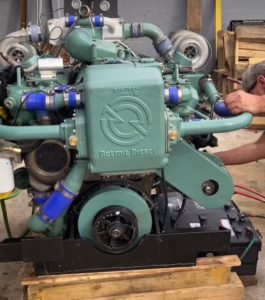November 26, 2024
General Safety Guidelines
Precautions When Working with Heavy Components
Handling Fluids and Chemicals
Electrical Safety
Specific Safety Precautions for Series 92 Engines
Emergency Preparedness
Maintenance Schedules and Recommended Practices for Detroit Diesel Series 92 Engines (6V92, 8V92, 12V92, 16V92)
Regular Maintenance Intervals for Detroit Diesel Series 92 Engines (6V92, 8V92, 12V92, 16V92)
Conclusion
Read More
November 26, 2024
General Specifications (Cylinder Configurations, Displacement, Compression Ratios)
The Detroit Diesel Series 92 engines are engineered with precision and built to deliver powerful performance across a wide range of applications. These engines are characterized by their modular design, offering various cylinder configurations, displacements, and compression ratios tailored to meet specific power demands. Here’s a detailed breakdown of the general specifications:
Cylinder Configurations
Engine Identification and Serial Number Location For 92 Series Engines (6V92, 8V92, 12V92, 16V92)
Understanding the Serial Number for Detroit Diesel 92 Series Engines (6V92, 8V92, 12V92, 16V92)
Importance of the Serial Number
Key Details Provided by the Serial Number
Using the Serial Number for Maintenance and Repairs
Additional Identification Tips
Verifying the Serial Number
Benefits of Accurate Identification
Conclusion
Read More
November 26, 2024
Overview and Key Features of the Series 92 Engines (6V92, 8V92, 12V92, 16V92)
Applications for Detroit Diesel 92 Series Engines (6V92, 8V92, 12V92, 16V92)
On-Highway Applications
Industrial Applications
Generator Sets
3. Industrial Operations
Marine Applications
Cross-Industry Reliability
Conclusion
Read More
November 18, 2024
Servicing Your Detroit Diesel 92 Series Engines - Part 1
Servicing Your Detroit Diesel 92 Series Engines - Part 2
Advanced Operation, Maintenance, and Diagnostics for Detroit Diesel 92 Series Engines (6V92, 8V92, 12V92, 16V92) - Part 3
Read More
November 18, 2024
Cylinder Head Bolts (Torque Specs)
Connecting Rod Cap Nuts (Torque Specs)
Main Bearing Cap Bolts (Torque Specs)
Flywheel Bolts (Torque Specs)
Accessory Drive Pulley Nut (Torque Specs)
Crankshaft Pulley Bolt (Torque Specs)
Vibration Damper Hub Bolt (Torque Specs)
Turbocharger Mounting Bolts (Torque Specs)
Exhaust Manifold Bolts (Torque Specs)
Oil Cooler Core Stud Nuts (Torque Specs)
Fresh Water Pump (Torque Specs)
Raw Water Pump Torque Specs
Rocker Arm Shaft Bolts (Torque Specs)
Injector Clamp Bolts (Torque Specs)
Standard Pipe Plugs (Torque Specs)
Camshaft Gear Locknut (Torque Specs)
Read More
November 18, 2024
Disassembly: Step-by-Step Guide
1. Preparations
2. Remove External Components
Air Intake and Exhaust Systems
Cooling System
Fuel System
Electrical Components
Inspection After Component Removal
3. Remove the Cylinder Head
1. Preparations
2. Valve Train Removal
3. Cylinder Head Bolts
4. Lift the Cylinder Head
5. Inspect Components
Process to Measure Flatness
6. Additional Checks (if Necessary)
Tools Needed for Cylinder Head Removal
4. Remove Pistons, Connecting Rods, and Cylinder Liners
1. Preparations
2. Removing Pistons and Connecting Rods
3. Removing Cylinder Liners
4. Inspection and Measurements
Cylinder Liner Inspection
Replacement Decision
5. Reassembly Preparation
Key Tips
5. Clean and Inspect All Components
Cleaning
Inspection
Inspection Steps:
Procedure:
Main Journal Measurements
Connecting Rod Journal Measurements
Inspection Steps
When to Replace
Key Notes
Reassembly: Detailed Instructions
1) Install Cylinder Liners
2) Install Pistons and Rings
3) Reassemble the Cylinder Head
4) Reinstall Connecting Rod Caps
5) Final Assembly
Testing the Engine
Dynamometer Test Specifications
Pre-Test Setup
Testing Procedure
Post-Test Inspection
Key Tips for Success
Read More

Page 81 of 107
« First
«
...
10
20
30
...
79
80
81
82
83
...
90
100
...
»
Last »












